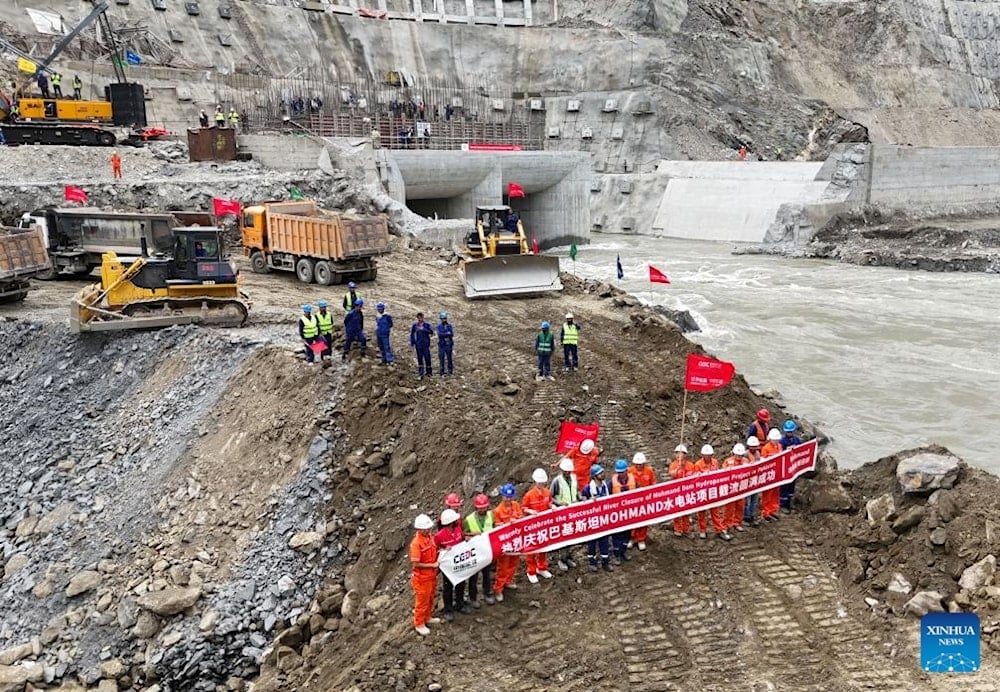China pushes Pakistan dam construction after India threatens water cut
China accelerates work on a major Pakistani dam after India threatened to suspend the Indus Waters Treaty and raised regional tensions over water security.
-

The river closure at the site of the Mohmand Hydropower Project in Swat, Pakistan dated August 16, 2024 (China Gezhouba Group Corporation/Handout)
China says it is speeding up construction on a major dam project in Pakistan following India's threat to cut off water supplies from the Indus River system and escalate a long-standing regional dispute into a potential environmental and strategic crisis.
The Mohmand Hydropower Project, located in Khyber Pakhtunkhwa province in northwestern Pakistan, has reached a “critical construction milestone,” according to China’s state broadcaster CCTV, which reported that concrete filling on the dam has officially begun.
The Chinese statement comes amid rising tensions in the subcontinent after New Delhi threatened to suspend the 1960 Indus Waters Treaty, a pact widely regarded as a foundation of water-sharing stability between the two countries.
India’s move came following a militant attack in Indian-controlled Kashmir on April 22 that left 26 tourists dead. Accusing Pakistan of harboring militant groups, a charge Islamabad denies, Indian Prime Minister Narendra Modi has reportedly instructed officials to accelerate the development of water projects on the Chenab, Jhelum, and Indus rivers.
India’s expansive network of dams, including the massive Bhakra Nangal Dam, gives it significant capacity to alter water flows, prompting alarm in Islamabad, where over 80% of agriculture relies on the Indus system.
“Water is a vital national interest of Pakistan, a lifeline for its 240 million people, and its availability will be safeguarded at all costs,” the Pakistani government said, warning that any attempt to divert water would be viewed as an “act of war.”
Mohmand Dam: A flagship of China–Pakistan infrastructure ties
The Mohmand Dam, under construction since September 2019, is being developed by the China Energy Engineering Corporation. It is designed as a multi-purpose project to generate 800 megawatts of hydropower, provide flood control, supply irrigation, and deliver 300 million gallons per day of drinking water to Peshawar, the provincial capital.
Originally slated for completion in 2026, the dam is now being fast-tracked, with Chinese state media describing it as a “national flagship project” under Pakistan’s water security strategy.
The dam is part of the cooperation between Beijing and Islamabad under the China–Pakistan Economic Corridor (CPEC), a key component of China’s global Belt and Road Initiative (BRI). Other megaprojects include the Diamer-Bhasha Dam, also being built on the Indus, aimed at boosting Pakistan’s long-term water storage capacity.
Although China maintains a long-standing diplomatic and military partnership with Pakistan, which it calls an “ironclad brotherhood,” it has urged restraint from both Islamabad and New Delhi.
Beijing, which has its own unresolved border disputes with India, including the flashpoint Galwan Valley where a deadly clash occurred in 2020, refrained from directly criticizing either party during the clashes. However, its decision to spotlight the progress on the Mohmand project is being interpreted by regional analysts as a symbolic signal of strategic commitment.
Despite American and Indian pressure on China to reduce its backing of Pakistan’s infrastructure and defense development, Beijing continues to provide critical technological and financial support to projects crucial for Pakistan’s sovereignty over water and energy.
Water security emerges as new flashpoint in regional rivalry
Pakistan’s vulnerability was laid bare during the 2022 “superfloods”, which devastated crops and left millions displaced. With agriculture accounting for a significant share of GDP and employment, any disruption to water access could have cascading economic and humanitarian consequences.
India’s threats to redraw water flows, in violation of a longstanding treaty, have raised fears of a new dimension of conflict, where hydropolitics and climate risks intersect with nuclear deterrence and conventional tensions.
Under the Indus Waters Treaty, signed in 1960 with World Bank mediation, India is entitled to the eastern rivers, Ravi, Sutlej, and Beas, while Pakistan holds rights to the western tributaries, including the Indus, Chenab, and Jhelum.

 4 Min Read
4 Min Read








